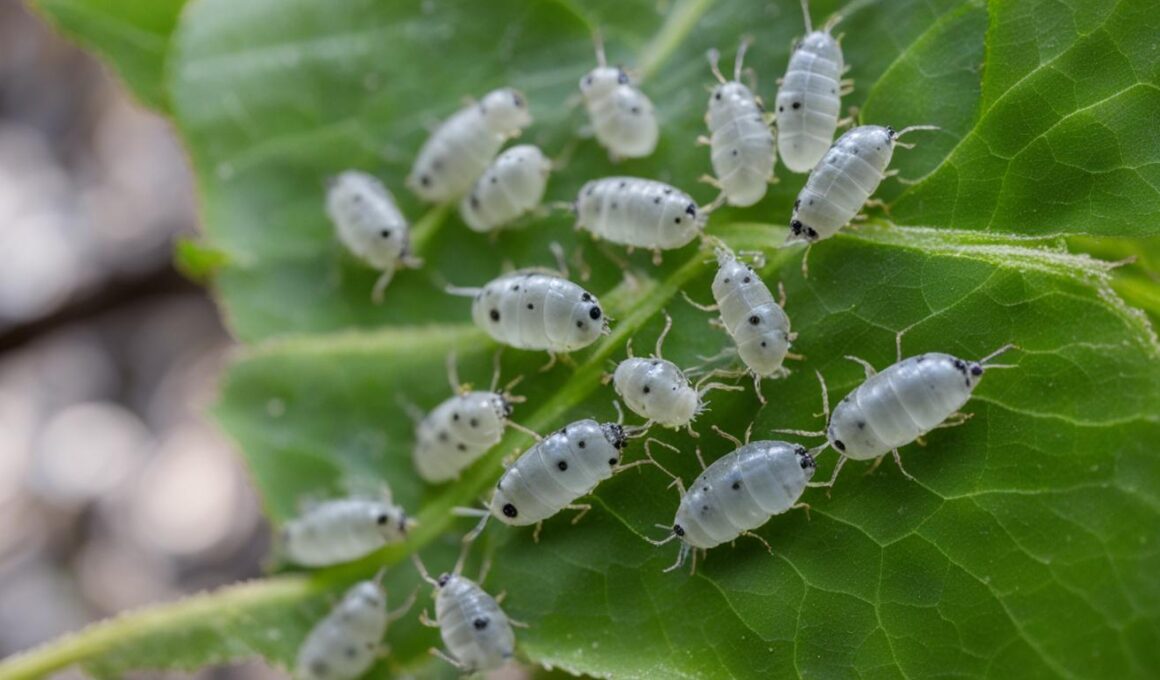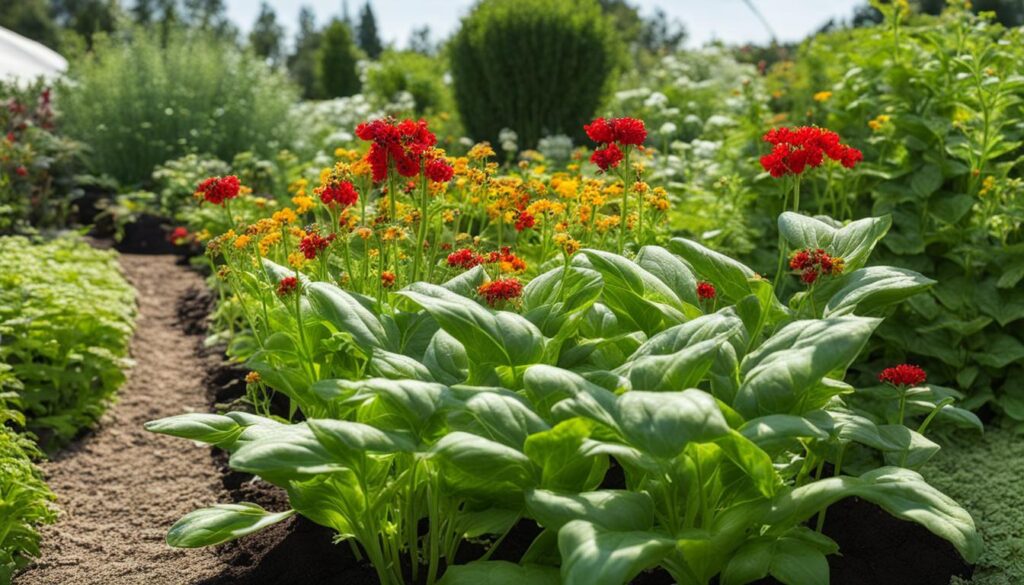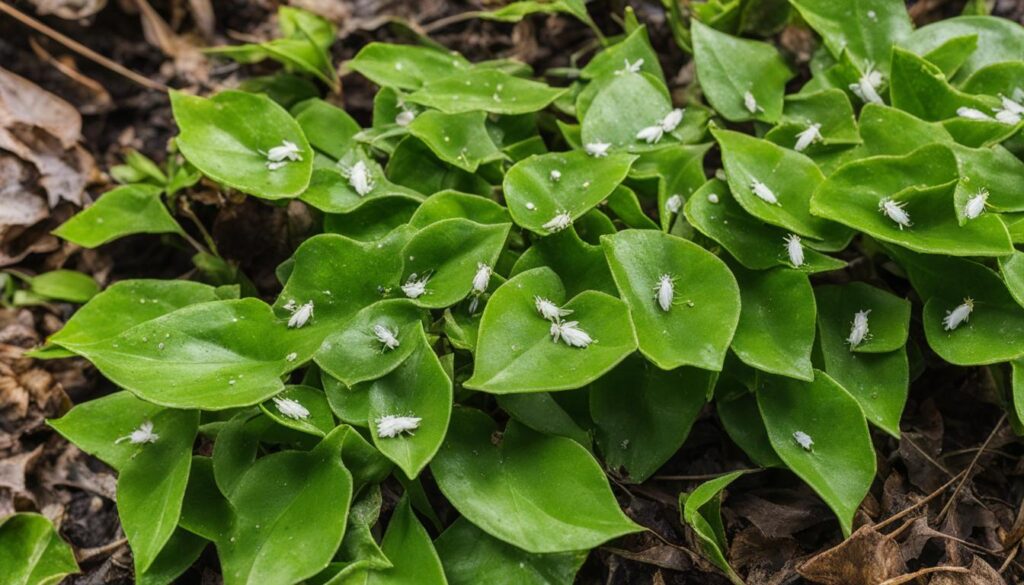Whiteflies larvae can be a persistent and damaging pest in your garden, but with the right strategies, you can effectively combat their infestations. These small insects reproduce rapidly, causing damage to native vegetation, ornamental plants, and food crops. By implementing targeted methods and preventive measures, you can protect your plants and enjoy a pest-free outdoor space.
Key Takeaways:
- Implement a variety of strategies to target the life cycle of whiteflies larvae and prevent infestations.
- Understand the identification and life cycle of whiteflies to effectively combat them.
- Use natural methods like vacuuming, soap sprays, and attracting birds to control whitefly infestations.
- Consider professional pest control services for severe infestations.
- Prevention is key – practice good garden hygiene and maintain a clean yard to reduce the risk of whitefly infestations.
Understanding Whiteflies: Identification and Life Cycle
Whiteflies are small, sap-sucking insects that can be found on plants in warm weather. They are characterized by a white, waxy material on their bodies and wings, hence their name. These pests are particularly destructive to native vegetation and crops, and they reproduce rapidly, leading to quick infestations in gardens and yards. Understanding the identification and life cycle of whiteflies is crucial in effectively combating them and preventing further damage to your plants.
Whiteflies go through four stages in their life cycle: egg, nymph, pupa, and adult. The eggs are usually laid on the undersides of leaves and are oval-shaped. Once the eggs hatch, they enter the nymph stage, during which they feed on plant sap and develop into immature whiteflies. Nymphs resemble tiny, scale-like creatures and are often found clustered together on the undersides of leaves.
After going through several molts, the nymphs enter the pupa stage, during which they undergo significant physical changes. The pupa is immobile and enclosed in a protective covering. Finally, adult whiteflies emerge from the pupal stage and begin mating and laying eggs, continuing the life cycle. This entire process can occur within as little as two to four weeks, allowing whitefly populations to grow rapidly if left unchecked.
| Stage | Description |
|---|---|
| Egg | Oval-shaped eggs laid on the undersides of leaves |
| Nymph | Immature whiteflies that resemble tiny, scale-like creatures |
| Pupa | Immobile stage with significant physical changes |
| Adult | Mature whiteflies that mate, lay eggs, and continue the life cycle |
By understanding the life cycle of whiteflies and being able to identify the various stages, you can implement targeted control strategies at the appropriate times. Regularly inspect your plants for signs of whitefly infestations, including the presence of adult whiteflies, nymphs, and eggs on the undersides of leaves. Taking early action to combat whiteflies can help prevent the damage they cause and maintain the health of your garden.
Natural Methods to Control Whiteflies Infestations
Whiteflies can be a persistent annoyance in your garden, but there are several natural methods you can use to control their infestations and protect your plants. These methods are safe, environmentally friendly, and effective in reducing whitefly populations.
1. Vacuuming up adult whiteflies
One effective way to control whiteflies is to use a handheld vacuum cleaner to physically remove adult whiteflies from your plants. This method can help reduce the number of whiteflies and prevent them from laying eggs, disrupting their life cycle.
2. Using dish soap and water sprays
A mixture of mild dish soap and water can be sprayed onto the leaves of infested plants to suffocate and kill whiteflies. The soap disrupts their delicate outer coating, causing them to dehydrate and die. Make sure to thoroughly cover both the upper and lower surfaces of the leaves for maximum effectiveness.
3. Planting whitefly repelling plants
Some plants, such as marigolds, nasturtiums, and basil, have natural properties that repel whiteflies. By incorporating these plants into your garden, you can help deter whiteflies from infesting your other plants. Plus, these repellent plants add beauty and variety to your garden.
| Plant Name | Repelling Properties |
|---|---|
| Marigolds | Strong scent repels whiteflies |
| Nasturtiums | Produces a mustard oil that repels whiteflies |
| Basil | Strong aroma repels whiteflies |
4. Using sticky traps
Sticky traps are a simple yet effective way to trap adult whiteflies. These traps are coated with a sticky substance that traps the insects when they come into contact with it. Place the traps near your infested plants to help reduce the whitefly population.
By implementing these natural methods, you can control whiteflies infestations in your garden and protect your plants from their damage. Remember to regularly monitor your plants for signs of whitefly activity and take prompt action to prevent further infestations.
Professional Whitefly Control Services
If you have a severe whitefly infestation in your garden that cannot be controlled by natural methods, it may be necessary to seek the help of a professional pest control service. Professional exterminators have the expertise and experience to examine your yard, identify factors that promote whitefly population growth, and provide effective treatment options. They can ensure that the infestation is completely eliminated and prevent its return. If you are unsure about the severity of your whitefly problem, it is always best to contact a professional for assistance.
Why Choose Professional Pest Control?
Professional pest control offers several advantages when it comes to combating whitefly infestations. Firstly, pest control professionals have the knowledge and training to accurately identify whiteflies and distinguish them from other similar insects. This ensures that the right treatment methods are used, minimizing the risk of ineffective or harmful solutions.
Additionally, professional exterminators have access to advanced tools and equipment that are not readily available to homeowners. These tools can effectively target whitefly larvae and adults, eliminating the infestation more efficiently and reducing the chances of reinfestation.
Furthermore, pest control professionals can provide ongoing monitoring and preventive measures to ensure that whiteflies do not return to your garden. They can offer advice on proper garden maintenance and implement proactive strategies to keep whiteflies at bay in the long term.
Choosing the Right Pest Control Professional
When selecting a pest control professional to handle your whitefly infestation, it is important to consider a few key factors. Look for a licensed and insured company with a proven track record of successfully treating whitefly problems. You can also ask for recommendations from friends, neighbors, or gardening clubs in your area.
It is advisable to request multiple quotes from different pest control companies to compare their services and prices. A reputable professional will conduct a thorough inspection of your garden, provide a written estimate, and explain the treatment plan in detail. They should also be willing to address any questions or concerns you may have before proceeding with the treatment.
Prevention Strategies for Whiteflies Infestations
Preventing whitefly infestations is crucial for maintaining a healthy garden. By implementing a few key strategies, you can significantly reduce the risk of whiteflies and keep your plants thriving. Here are some effective prevention methods to consider:
- Maintain a clean and tidy garden: Regularly remove weeds, fallen leaves, and any other debris that can attract whiteflies. This decreases their hiding places and breeding grounds, making your garden less appealing to these pests.
- Ensure proper sunlight: Whiteflies prefer shaded areas, so trim back overgrown plants and branches that create dense shade. Allowing adequate sunlight to reach your plants will discourage whiteflies from settling in.
- Plant whitefly repelling plants: Some plants naturally repel whiteflies, such as marigolds, basil, and petunias. By interplanting these species with your vulnerable plants, you can help deter whiteflies and create a more pest-resistant garden.
- Attract natural predators: Encouraging beneficial insects, such as ladybugs and lacewings, to inhabit your garden can help control whitefly populations. Planting flowers like daisies and yarrow can attract these predators and create a more balanced ecosystem.
- Practice good garden hygiene: Regularly inspect your plants for signs of whiteflies and take immediate action if you spot any. Promptly remove and destroy infested plants to prevent the pests from spreading.
By incorporating these prevention strategies into your garden maintenance routine, you can create an environment that is less attractive to whiteflies and reduce the likelihood of infestations.
Table: Whitefly-Repelling Plants
| Plant | Benefits |
|---|---|
| Marigolds | Strong scent repels whiteflies |
| Basil | Repels whiteflies and other garden pests |
| Petunias | Attracts beneficial insects that prey on whiteflies |
| Daisies | Attracts ladybugs, lacewings, and other natural predators of whiteflies |
| Yarrow | Attracts lacewings and other beneficial insects |
Integrating these whitefly-repelling plants into your garden not only adds beauty but also serves as a natural defense against whitefly infestations.
Remember, prevention is key when it comes to whiteflies. By implementing these strategies, you can minimize the risk of infestations and create a thriving, pest-free garden.
Signs and Symptoms of Whitefly Infestations
If you suspect a whitefly infestation in your garden, it is important to be able to recognize the signs and symptoms. By identifying these early indicators, you can take immediate action to control the infestation and prevent further damage to your plants.
One of the most noticeable signs of a whitefly infestation is the presence of swarms of tiny flying insects around your plants. These pests are typically found on the undersides of leaves and can quickly multiply in numbers. Additionally, you may notice the presence of honeydew, a sticky substance excreted by whiteflies, along with black sooty mold. This mold can cover the leaves and stems of your plants, causing them to appear black and dirty.
“The presence of yellowing or wilting leaves is another common symptom of whitefly infestations.”
The presence of yellowing or wilting leaves is another common symptom of whitefly infestations. Whiteflies extract sap from the leaves, which weakens the plants and leads to their decline. Lastly, whitefly infestations can cause plant distortion, such as curling or twisting of leaves, stunted growth, or deformed fruits and flowers.
Table: Signs and Symptoms of Whitefly Infestations
| Signs and Symptoms | Description |
|---|---|
| Swarms of tiny flying insects | Whiteflies gather in large numbers, often on the undersides of leaves. |
| Honeydew and black sooty mold | Whiteflies excrete a sticky substance that attracts mold, causing a black, sooty appearance on the leaves and stems. |
| Yellowing or wilting leaves | Whiteflies extract sap from the leaves, causing them to turn yellow and eventually wilt. |
| Plant distortion | Whitefly infestations can lead to curled or twisted leaves, stunted growth, and deformed fruits and flowers. |
If you observe any of these signs and symptoms in your garden, it is crucial to take immediate action. Implement the natural control methods mentioned in Section 3 or seek the assistance of a professional pest control service, as discussed in Section 4. By promptly addressing whitefly infestations, you can protect the health of your plants and maintain a pest-free garden.
Whiteflies and Their Impact on Different Plant Species
Whiteflies can have a significant impact on various plant species, causing damage and even death in some cases. It is important to understand which plants are susceptible to whitefly infestations in order to take appropriate preventive measures and protect your garden.
Food Crops: Whiteflies are particularly destructive to food crops such as beans, brassicas, citrus, cucumber, eggplant, grape, okra, peppers, potatoes, squash, and tomatoes. These pests can suck the sap from the leaves, causing yellowing, wilting, and stunted growth. In severe cases, whiteflies can lead to reduced yields and crop failure.
Greenhouse-Grown and Ornamental Plants: Whiteflies also affect greenhouse-grown and ornamental plants. They can infest plants like hibiscus, poinsettia, roses, and bedding plants, leading to leaf yellowing, distorted growth, and a general decline in plant health. Whiteflies can also produce honeydew, a sticky substance that attracts black sooty mold, further impacting the aesthetic appeal of these plants.
By understanding the susceptibility of different plant species to whiteflies, you can implement targeted prevention strategies. These may include regular monitoring, early detection, companion planting, and the use of organic insecticides. Taking proactive measures can help protect your plants from damage and ensure a thriving garden.
| Plant Species | Impact of Whiteflies |
|---|---|
| Beans | Leaf yellowing, stunted growth |
| Brassicas | Leaf yellowing, stunted growth |
| Citrus | Leaf yellowing, distorted growth |
| Cucumber | Leaf yellowing, stunted growth |
| Eggplant | Leaf yellowing, stunted growth |
| Grape | Leaf yellowing, distorted growth |
| Okra | Leaf yellowing, stunted growth |
| Peppers | Leaf yellowing, stunted growth |
| Potatoes | Leaf yellowing, stunted growth |
| Squash | Leaf yellowing, stunted growth |
| Tomatoes | Leaf yellowing, stunted growth |
| Hibiscus | Leaf yellowing, distorted growth |
| Poinsettia | Leaf yellowing, distorted growth |
| Roses | Leaf yellowing, distorted growth |
| Bedding plants | Leaf yellowing, distorted growth |
What Are the Best Methods for Controlling Whiteflies in Your Garden?
To achieve effective white fly larva control in your garden, consider using natural predators like ladybugs or lacewings. Another method is to regularly spray the affected plants with insecticidal soap or neem oil. Finally, introducing reflective mulches or yellow sticky traps can also help in reducing whitefly populations.
Conclusion
Controlling whiteflies in your garden requires a proactive approach and effective pest management strategies. By implementing the right methods, you can prevent whitefly infestations and protect your plants from damage.
Utilizing natural methods, such as vacuuming adult whiteflies, using soapy water sprays, and attracting beneficial insects, can significantly reduce whitefly populations in your garden. Additionally, maintaining a clean yard, proper watering, and using organic fertilizers contribute to the overall health of your plants and make them less susceptible to infestations.
In cases where natural methods are not sufficient, professional pest control services can provide effective treatment options tailored to your specific whitefly infestation. Their expertise and experience ensure that the problem is fully eradicated and measures are put in place to prevent future infestations.
In conclusion, with proper whitefly control and garden pest management strategies, you can protect your garden and enjoy a pest-free outdoor space. Stay vigilant, implement preventive measures, and take prompt action to keep whiteflies at bay. By doing so, you can maintain a thriving garden and preserve the health of your plants for years to come.
FAQ
What are whiteflies?
Whiteflies are small, sap-sucking insects that are often found on plants in warm weather. They have a characteristic white, waxy material on their bodies and wings.
How do whiteflies reproduce?
Whiteflies reproduce rapidly and can quickly infest a garden or yard. They lay eggs on the undersides of leaves, and the larvae emerge and feed on plant sap.
What plants are susceptible to whiteflies?
Whiteflies can have a significant impact on different plant species, including food crops such as beans, brassicas, citrus, cucumber, eggplant, grape, okra, peppers, potatoes, squash, and tomatoes, as well as greenhouse-grown and ornamental plants like hibiscus, poinsettia, roses, and bedding plants.
How can I control whitefly infestations naturally?
There are several natural methods that can be used to control whitefly infestations in your garden, including vacuuming up adult whiteflies, removing infested leaves, using dish soap and water sprays, checking nitrogen levels in the soil, applying mulch and fertilizer, watering plants properly, using earthworm casting, maintaining a clean yard, allowing sunlight, planting whitefly repelling plants, using sticky traps, attracting birds, and utilizing neem oil.
When should I seek professional pest control services for whiteflies?
If you have a severe whitefly infestation in your garden that cannot be controlled by natural methods, it may be necessary to seek the help of a professional pest control service. They can examine your yard, identify factors that promote whitefly population growth, and provide effective treatment options to eliminate the infestation.
What are the signs of whitefly infestations in my garden?
Signs of whitefly infestations in your garden include swarms of tiny flying insects, the presence of honeydew and black sooty mold, yellowing or wilting leaves, and plant distortion.
How can I prevent whitefly infestations in my garden?
You can prevent whitefly infestations by keeping your yard well-maintained, removing debris, ensuring proper sunlight, planting whitefly repelling plants, attracting natural predators, and practicing good garden hygiene.
What is the impact of whiteflies on plants?
Whiteflies can cause damage and even death to different plant species. They are particularly destructive to food crops and greenhouse-grown and ornamental plants.
How can I maintain a healthy garden and prevent whiteflies?
By implementing natural methods, seeking professional pest control services when needed, and practicing good garden maintenance, you can effectively combat whitefly infestations and maintain a healthy garden.











